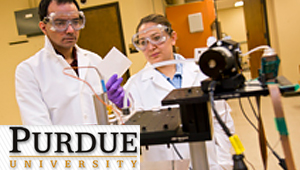Pinpointing Drug Dosage with Technology
By Nora Al Baghdadi
WEST LAFAYETTE, Ind. – Average recommended medication dosage for a patient is often outside of the optimum range for a specific individual. A research team, including several Purdue University professors as well as professors from other nearby schools, is now working on a system that can provide precise dosage without a trial and error adjustment for the patient.
Rather than rely on the clinical studies that recommend an average dose, the new prototype system uses a mathematical method to predict needed dosage, tailored to an individual patient. If the system proves capable of correctly performing its task, it would make a revolutionary medical advancement in enabling effective drug usage and limiting adverse patient reactions.
The system, created by the research team in Indiana, uses inkjet technology to produce the medication dosage. “Pharmaceutical companies make one or two or three dosage levels, so people try breaking tablets in half and other methods to get to the right dosage,” said Gintaras “Rex” Reklaitis, Purdue University‘s Professor of Chemical Engineering. This new system uses “drop on demand” technology to deposit exactly the medication dosage needed for the specific patient it is assessing.
The portable dosage system first dissolves or melts the drugs and then re-administers the drugs into the right size dose in new tablets or films. Strict technology control is needed to melt the medications, which is more difficult than dissolving, but offers some benefits with certain medications over solutions. “We envision that in its final form the printing will be done in an automated fashion. The pharmacist could key in the dose, the machine prints 20 tablets, and off you go,” said Reklaitis.
Leading the team of researches is Arun Giridhar, an associate research scientist at Purdue’s School of Chemical Engineering. He remarked, “If we say the patient needs 23 milligrams every eight hours, there is no 23-milligram tablet on the market. I can make a 23-milligram dose, but to make something that small and that precise is challenging to do with powders. It is much easier to dissolve or melt the drug formulation. Both are viable technologies.”
Original research for this dosage-prediction system was first revealed by Gary E. Blau who was a visiting professor at Purdue University’s School of Chemical Engineering and died earlier this year. His work lives on through funding by the National Science Foundation.
The importance of the dosage system has been two-fold – both the exact dosage drop and the patient dosage prediction are important advancements for the medical community. The team has developed two research papers to explain the dual benefits of this prototype and the research behind it.
Currently in personalized medicine, physicians use diagnostic methods and have not had access to mathematical tools to determine the best therapy for an individual patient. The work on printing, supported by the Indiana Next Generation Manufacturing Competitiveness Center and under the NSF Engineering Research Centers program, is currently undergoing clinical studies to test system effectiveness.
The professors from Purdue also include: Lynne S. Taylor from the industrial and physical pharmacy department; Michael T. Harris from the chemical engineering department and associate dean of undergraduate engineering; Zoltan Nagy from the chemical engineering department and an expert in process automation and control; and Joseph Pekny from the chemical engineering department and director of the Entrepreneurship Center. Additional professors on the research team from nearby schools include: Attaya Suvannasankha from the Indiana University School of Medicine, assistant professor of medicine; Christopher Fausel from Indiana University’s Simon Cancer Center, clinical manager of oncology pharmacy; and Elias J. Anaissie from the University of Cincinnati Cancer Center, former professor.
Researchers are currently working to develop a machine to predict individual dosage needs for patients and “print” the exact dosage size in tablet or film form.
Search
News

رئيس جامعة الناصر الاستاذ الدكتور عبدالله حسين طاهش يقوم بزيارة تفقدية للجان والقاعات الامتحانية الخاصة بكلية الهندسة وعلوم الحاسوب الاثنين 24 فبراير 2025
قام رئيس الجامعة الاستاذ الدكتور عبدالله حسين ط...
جامعة الناصر تنظم ورشة حول التهيئة الرمضانية لمنتسبيها
نظمت جامعة الناصر صباح اليوم الأثنين 25 شعبان 1...
اختتام المؤتمر العلمي الأول للجامعات اليمنية في صنعاء
اختتم اليوم في العاصمة صنعاء، أعمال المؤتمر الع...
لليوم الثاني على التوالي، استمرار أعمال ونقاشات المؤتمر العلمي الأول للجامعات اليمنية.
تستمر في العاصمة صنعاء لليوم الثاني على التوالي...
بمشاركة جامعة الناصر وبحضور رسمي رفيع انطلاق المؤتمر العلمي الأول في صنعاء
صنعاء 20 شعبان 1446 هجرية الموافق 18 فبراير 202...

